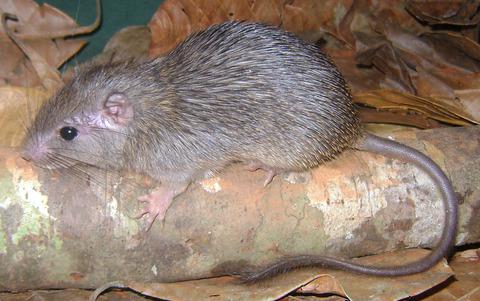当前位置:
X-MOL 学术
›
Ecol. Evol.
›
论文详情
Our official English website, www.x-mol.net, welcomes your
feedback! (Note: you will need to create a separate account there.)
New karyotype for Mesomys stimulax (Rodentia, Echimyidae) from the Brazilian Amazon: A case for species complex?
Ecology and Evolution ( IF 2.3 ) Pub Date : 2021-05-08 , DOI: 10.1002/ece3.7583 Stella Miranda Malcher 1 , Julio Cesar Pieczarka 1 , Adenilson Leão Pereira 2 , Paulo José Siqueira do Amaral 3 , Rogério Vieira Rossi 4 , Juliane Saldanha 4 , Cleusa Yoshiko Nagamachi 1
Ecology and Evolution ( IF 2.3 ) Pub Date : 2021-05-08 , DOI: 10.1002/ece3.7583 Stella Miranda Malcher 1 , Julio Cesar Pieczarka 1 , Adenilson Leão Pereira 2 , Paulo José Siqueira do Amaral 3 , Rogério Vieira Rossi 4 , Juliane Saldanha 4 , Cleusa Yoshiko Nagamachi 1
Affiliation

|
Mesomys Wagner, 1845 (Rodentia, Echimyidae, Eumysopinae) currently has four recognized species, three of which occur in Brazil: Mesomys hispidus (probably a species complex), M. occultus, and M. stimulax. Mesomys leniceps is found in montane forests of northern Peru. Mesomys stimulax, the focus of the present study, has a distribution that is restricted to the central and eastern Amazonia south of the Amazon River, extending from the left bank of the Tapajós River to the right bank of the Tocantins River, and south to the southeast portion of Pará State. The genus presents karyotypes with diploid number 2n = 60 and Fundamental Number (FN) = 116 for M. hispidus and M. stimulax, and 2n = 42, FN = 54 for M. occultus. We studied the karyotype of a female specimen of M. stimulax collected from the Tapirapé-Aquiri National Forest, Marabá, Pará, Brazil, in the Xingu/Tocantins interfluvium. The obtained karyotype (2n = 60 and FN = 110) differs from that described in the literature for both M. stimulax and M. hispidus by exhibiting more biarmed chromosomes, probably due to pericentric inversions and/or centromeric repositioning, and exhibiting differences in the amount and distribution of constitutive heterochromatin (CH). These results suggest that, similar to what has already been proposed for M. hispidus, M. stimulax may represent a species complex and/or cryptic species. The mechanisms of chromosomal diversification in Mesomys and the biogeographic implications are discussed reinforcing the need for broad systematic review for Mesomys.
中文翻译:

来自巴西亚马逊的 Mesomys stimulax(啮齿目,Echimyidae)的新核型:物种复杂性的案例?
Mesomys Wagner, 1845(啮齿目、Echimyidae、Eumysopinae)目前有四个公认物种,其中三个出现在巴西: Mesomys hispidus (可能是一个物种复合体)、 M .神秘学,和M。刺激。 Mesomys leniceps发现于秘鲁北部的山地森林中。 Mesomys stimulax是本研究的重点,其分布仅限于亚马逊河以南的亚马逊中部和东部地区,从塔帕若斯河左岸延伸到托坎廷斯河右岸,向南延伸到亚马逊河流域。帕拉州东南部。该属呈现出二倍体数 2n = 60 和M的基本数 (FN) = 116 的核型。刚毛和M .刺激,且M为 2n = 42,FN = 54。神秘学。我们研究了M雌性标本的核型。刺激物采集自巴西帕拉州马拉巴市的塔皮拉佩-阿基里国家森林辛古/托坎廷斯河间流域。获得的核型(2n = 60 和 FN = 110)与文献中描述的M不同。刺激和M 。硬毛的特征是表现出更多双臂染色体,可能是由于着丝粒周倒位和/或着丝粒重新定位,并表现出组成型异染色质(CH)的数量和分布差异。这些结果表明,类似于已经为M提出的内容。刚毛, M .刺激可以代表物种复合体和/或神秘物种。 讨论了Mesomys染色体多样化的机制及其生物地理学意义,强调了对Mesomys进行广泛系统评价的必要性。
更新日期:2021-06-22
中文翻译:

来自巴西亚马逊的 Mesomys stimulax(啮齿目,Echimyidae)的新核型:物种复杂性的案例?
Mesomys Wagner, 1845(啮齿目、Echimyidae、Eumysopinae)目前有四个公认物种,其中三个出现在巴西: Mesomys hispidus (可能是一个物种复合体)、 M .神秘学,和M。刺激。 Mesomys leniceps发现于秘鲁北部的山地森林中。 Mesomys stimulax是本研究的重点,其分布仅限于亚马逊河以南的亚马逊中部和东部地区,从塔帕若斯河左岸延伸到托坎廷斯河右岸,向南延伸到亚马逊河流域。帕拉州东南部。该属呈现出二倍体数 2n = 60 和M的基本数 (FN) = 116 的核型。刚毛和M .刺激,且M为 2n = 42,FN = 54。神秘学。我们研究了M雌性标本的核型。刺激物采集自巴西帕拉州马拉巴市的塔皮拉佩-阿基里国家森林辛古/托坎廷斯河间流域。获得的核型(2n = 60 和 FN = 110)与文献中描述的M不同。刺激和M 。硬毛的特征是表现出更多双臂染色体,可能是由于着丝粒周倒位和/或着丝粒重新定位,并表现出组成型异染色质(CH)的数量和分布差异。这些结果表明,类似于已经为M提出的内容。刚毛, M .刺激可以代表物种复合体和/或神秘物种。 讨论了Mesomys染色体多样化的机制及其生物地理学意义,强调了对Mesomys进行广泛系统评价的必要性。











































 京公网安备 11010802027423号
京公网安备 11010802027423号